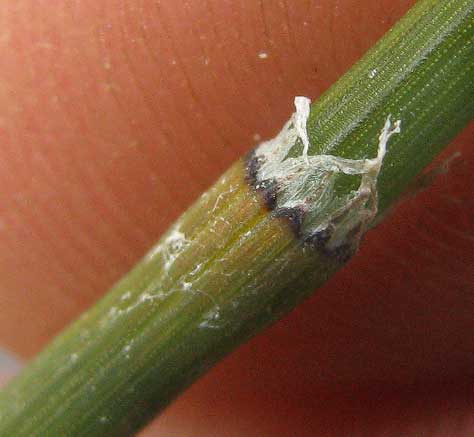Excerpts from Jim Conrad's
Naturalist Newsletter
from the January 5, 2014 Newsletter issued from the Frio Canyon Nature Education Center in the valley of the Dry Frio River in northern Uvalde County, southwestern Texas, on the southern border of the Edwards Plateau; elevation ~1750m (~5750 ft); N29.62°, W99.86°; USA
SMOOTH HORSETAIL
Arising from mud at the Dry Frio's edge were several stiff, green, knee-high stems conspicuously segmented with black and white bands, as shown below:

Up close the segment joints displayed the interesting features shown below:

Anyone who has spent much time along streams recognizes this as a horsetail or scouring rush. It's a spore producing plant, whose spores escape from cones atop the stems. Our stems had lost their cones, possibly from nibbling deer.
Horsetails are very primitive plants. Earth's first flowering plants appeared about 160 million years ago but horsetails are at least twice as old, their first fossil records occurring in rocks of late Devonian age -- 340-360 million years ago. At that time land plants were just getting established, experimenting with the possibilities of having roots, stems and leaves. The dark "teeth" at the joints in the above photo are the horsetail's notion of "leaves." Horsetails are genuine "living fossils." In former times horsetails constituted a major plant group; there were forests of them. The few species we have today are just a tiny fraction of what once existed.
In our area we can look for two similar-looking horsetail species. Though if you scrape a fingernail over our plant's stem it feels like very fine sandpaper, our plant is the Smooth Horsetail, or Smooth Scouring Rush, EQUISETUM LAEVIGATUM. It occurs on riverbanks and in other moist environments all through North America and northern Mexico.
Smooth Horsetails are thought of as having stems lasting less than a year, while stems of the other species, the Rough Horsetail or Rough Scouring Rush, last for more than a year. Still, you can see that our Smooth Horsetail stems are in good shape late in the season. In fact, I find the two species hard to distinguish, at least when the cones are absent. On Smooth Horsetails cone tips are fairly rounded, while the Rough's are pointed. You see that our Smooth's joints bear one narrow, dark band. The Rough's joints often bear two, but not always.
Horsetails are sometimes called scouring rushes because their stems are coated with abrasive silicates, making the stems useful for scouring dishes.